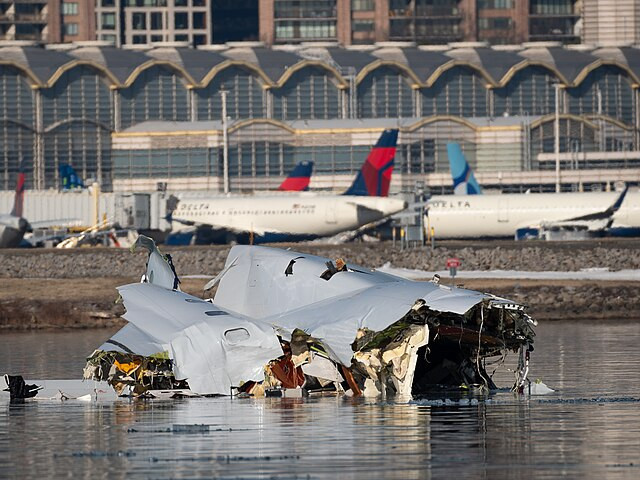Investigators probing the deadly collision between a U.S. Army Black Hawk helicopter and an American Airlines jet near Washington, D.C.'s Ronald Reagan National Airport on January 29 have determined that the helicopter crew may have missed crucial air traffic control instructions and received inaccurate altitude data in the moments leading up to the crash.
National Transportation Safety Board (NTSB) Chairwoman Jennifer Homendy told reporters Friday that the Black Hawk crew was likely unable to hear a key transmission from air traffic controllers instructing them to maneuver behind the commercial aircraft. "That transmission was interrupted - it was stepped on," Homendy said, explaining that the helicopter's microphone key was pressed at the same moment, blocking part of the message.
Investigators also found that a second transmission, informing the Black Hawk crew that the American Airlines flight was changing runways, may have been partially inaudible to them. The crash, which resulted in the deaths of all 67 people aboard both aircraft, is the deadliest aviation accident in the United States since 2001.
Homendy cautioned that the investigation is still in its early stages and that it could take over a year for the NTSB to complete its final report. "We're only a couple weeks out," she said. "We have a lot of work to do."
Conflicting Altitude Data and Night Vision Use
Preliminary findings indicate that the collision occurred at approximately 325 feet. However, cockpit conversations suggest the Black Hawk's crew received inconsistent altitude readings. Homendy stated that one pilot called out an altitude of 300 feet while the instructor pilot reported 400 feet. The helicopter's black box recorded a radio altitude of 278 feet at the time of impact, but it is unclear what was displayed on the cockpit's barometric altimeters.
"That does not mean that's what the Black Hawk crew was seeing on the barometric altimeters in the cockpit," Homendy warned, emphasizing that investigators are analyzing whether the pilots were relying on faulty altitude data.
The NTSB is also examining the potential effects of night vision goggles, which the helicopter crew was wearing as part of a check flight. The mission involved an annual test for the pilot, including an evaluation of their ability to fly with night vision equipment.
Aviation safety expert William Waldock of Embry-Riddle Aeronautical University noted that night vision goggles restrict peripheral vision, which may have contributed to the crash. "If they did indeed lock onto that departing airplane and assume that's the traffic they were supposed to be avoiding, they didn't see the other airplane coming," he said.
Timeline of Communications Before the Collision
Roughly two minutes before impact, an air traffic control transmission was recorded on the commercial jet's cockpit voice recorder, warning the Black Hawk crew that a jet was circling at 1,200 feet. Homendy said data from the Black Hawk's cockpit voice recorder "indicated that the portion of the transmission stating the [jet] was circling may not have been received by the Black Hawk crew."
Twenty seconds before the crash, air traffic control asked the Black Hawk crew if they had the jet in sight. Seven seconds later, the crew confirmed visual contact. Three seconds before the collision, a directive was issued instructing the helicopter to "pass behind" the American Airlines flight. The Black Hawk's cockpit voice recorder suggests that this critical phrase was not heard due to a simultaneous transmission from the helicopter's mic.
"The Black Hawk was keying the mic to communicate with ATC," Homendy explained, meaning the transmission was blocked from reaching the crew. Instead, the helicopter's instructor pilot directed the pilot flying to move toward the east bank of the Potomac River, potentially misinterpreting the air traffic control instructions.
Victims and Response
The Army has identified the Black Hawk crew as Capt. Rebecca M. Lobach of Durham, North Carolina; Staff Sgt. Ryan Austin O'Hara, 28, of Lilburn, Georgia; and Chief Warrant Officer 2 Andrew Loyd Eaves, 39, of Great Mills, Maryland. The American Airlines jet, which was arriving from Wichita, Kansas, was piloted by 34-year-old Jonathan Campos.
The passengers included students, parents, members of the Skating Club of Boston, and a group of hunters returning from a trip. Among them were elite junior figure skaters who had attended a development camp following the 2025 U.S. Figure Skating Championships.
President Donald Trump initially blamed the Black Hawk crew for flying too high but later shifted his criticism to the U.S. air traffic control system, calling it "obsolete." When pressed for evidence supporting his claims, the president provided none.
Next Steps in the Investigation
The NTSB will conduct further analysis on the Black Hawk's flight data to determine how the conflicting altitude information may have affected the pilots' decision-making. Investigators will work with Sikorsky, the Black Hawk's manufacturer, and Collins Aerospace, which handles avionics systems, to assess whether erroneous data extended beyond the flight recorder.
Additionally, a visibility study will be conducted to assess what the helicopter crew could see through their night vision goggles in the moments leading up to the crash.
Homendy reiterated that the full investigation remains ongoing. "We need to follow our process and be meticulous," she said. "Ultimately, this work will determine the altitude displayed to the pilots and will be included in our final report."






